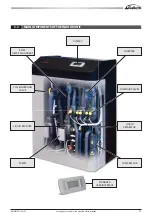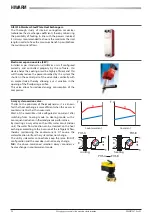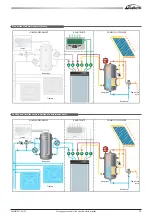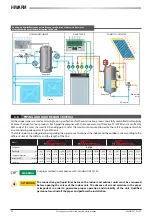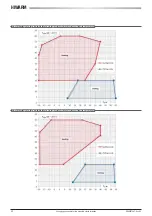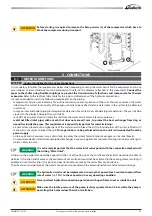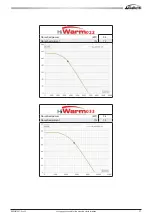
23
All copying, even partial, of this manual is strictly forbidden
RG66007967 - Rev 02
HFC R410A is distinguished by very
favourable thermal conductivity of the
liquid and negligible Glide, even if this results
in a higher GWP than other refrigerants
(Global Warming Potential GWP= 1975 kg
CO
2
), which lead to signifi cantly enhanced
evaporation performance together
with improved condenser performance.
The greater operating pressures and a
favourable pressure curve (temperature)
allow more compact thermal exchange
geometries to be used, which present a
smaller internal volume compared to the
same exchange surface, and therefore
require less refrigerant charge: these factors lead to a reduction of the overall GWP of the unit compared to products with
other types of ecological refrigerants of the HFC family.
The GWP of R410A is 1,975 kg CO
2
against the 1,177 of R407C and 1,410 of R134a. This disadvantage is made up for with the
greater EER and even better ESEER. The GWP is greater than other HFC fl uids, but the TEWI (total equivalent warming impact)
is much less, thanks to the high effi
ciency and reduced refrigerant charge.
With an average increase of 8% in the surface, the internal volume of the coils is 23% less. The average density is in turn lower
and therefore the R410A charge is approximately 27% less than that of R407C units of the same size.
20%
operating energy
(supplied by renewable
photovoltaic panels)
100%
useable
kW
80%
energy
absorbed from the environment
(renewable “clean” energy)
TEWI: Total Equivalent Warming Impact:
This expresses the mass of CO
2
that produces the same overall eff ect as the
chiller during its operational life. The main feature of this parameter is based on
the eff ects of using a refrigerant gas, which do not only derive from the possible
accidental emission into the atmosphere, but also the eff ect on global warming
generated by the carbon dioxide emitted for energy to be produced to operate
the chiller in question. The TEWI is defi ned as the sum of the direct and indirect
eff ect:
TEWI=
α
CO2
· E + GWP · m
ref
t &FOFSHZDPOTVNFECZUIFDIJMMFSEVSJOHJUTPQFSBUJPOBMMJGF
t Ⱥ
CO2
= amount of carbon dioxide emitted to produce one kWh of
electrical energy, and which depends on how it is generated.
t N
ref
= refrigerant charge.
In order to assess the TEWI, it is therefore necessary to estimate the effi
ciency of the chillers from which the energy
consumption, their life, the type of energy source from which it is drawn and the mass of refrigerant contained depend.
Besides the control of emissions into the atmosphere and the choice of environment-compatible refrigerants, this type
of approach also focuses on improving the overall effi
ciency of the chiller, which can play an important role on the actual
impact that a fl uid has on global warming, depending on the applications.
R410A refrigerant fl uid:













